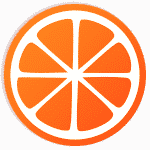 |
| Which black circle is larger? |
I’ve mentioned my adoration for Brian Wansink before. For those of you who aren’t enthralled with food research he’s the author of Mindless Eating. Much of his research focuses on external cues that affect our eating. Everything from what we’re told about a food to the lighting in a room has an impact on what we ultimately eat. I was interviewed for a GMA segment, that should air today, about the Wansink’s most recent research. This study entitled “Plate Size and Color Suggestibility: The Delboeuf Illusion’s Bias on Serving and Eating Behavior” looked at food color, plate color and the amount of food we eat.
The main conclusion was that we eat less food when the plate and the food are contrasting colors. Conversely, we eat more when food and plate are more tonal. To GMA’s credit they conducted an informal study at a NYC restaurant to replicate or challenge the study results. Sure enough (and thankfully for the producers’ sake) particpants plated significantly less (2 ounces less or almost 30%) pasta pomodoro on white plates than they did on red plates. While I’m not saying pasta pomodoro on white plates is the answer to your weight loss dreams. The plate/food color is something to think about.
So what is the explanation for the color and consumption connection? It’s related to an optical illusion with concentric circles (see top). When “two circles of identical size have been placed near to each other and one is surrounded by an annulus; the surrounded circle then appears larger than the non-surrounded circle if the annulus is close, while appearing smaller than the non-surrounded circle if the annulus is distant.” Thank you Wikipedia for that. For those of you, like me, who didn’t learn annulus when studying for the SATs, it means ring. The contrasting color in the study provides the close annulus and the net net is that the food on the plate will appear larger.
If you have white plates, you don’t need to do much other that eat the way practically all nutritionist’s suggest which is brightly colored food. Should you buy a second set of plates for when you have cauliflower or grilled chicken? Probably not. And I don’t foresee people going to restaurants and BYOP (bringing their own plate) as this crosses into eating idiocy. However, if you’re in the market for plates I would suggest white, small ones. And unlike food and plates, the researchers found table linens should be a similar color to your plate or the illusion is ruined. Coincidentally, my new plates from my favorite place in SF, Health Ceramics, are different colors and shapes. How versatile.
 |
| slightly concerned about oatmeal in the beige bowl |
Do you pay attention to how external cues (sound, lighting, company) affects your eating? What type of plates do you own? What do you think of the circles above, does the one on the left appear larger?

